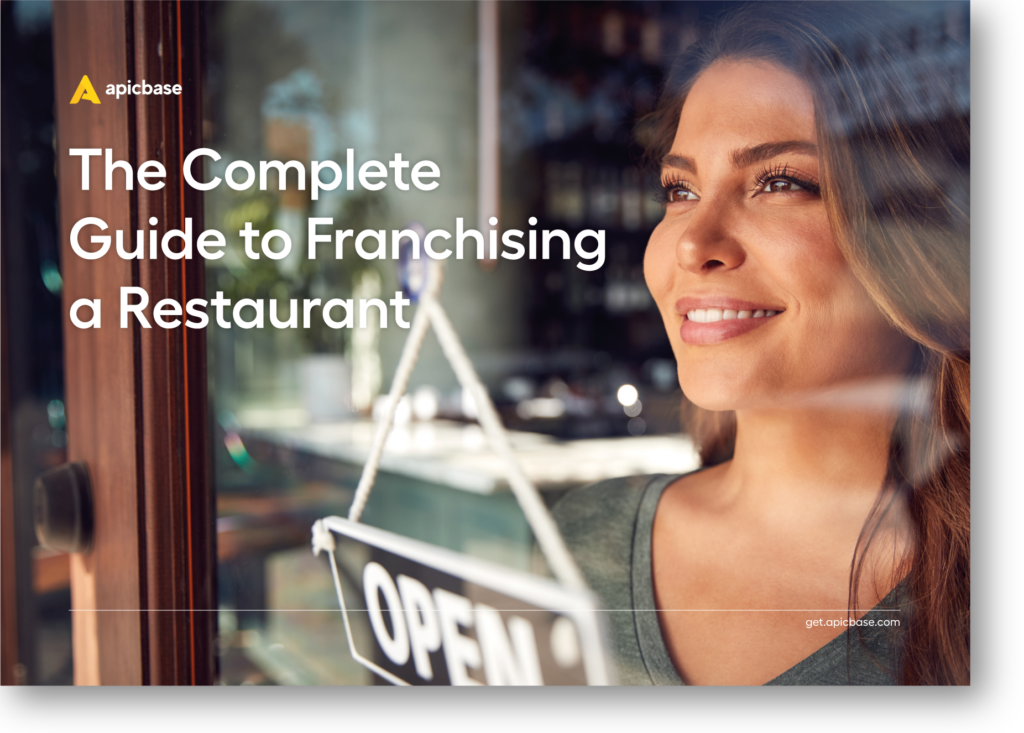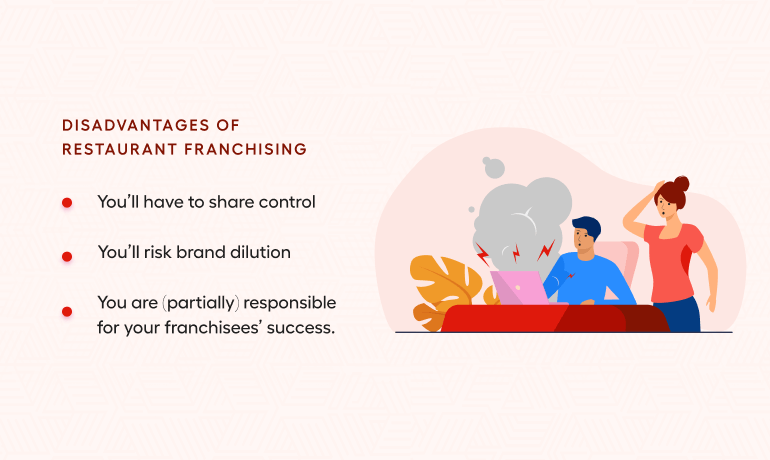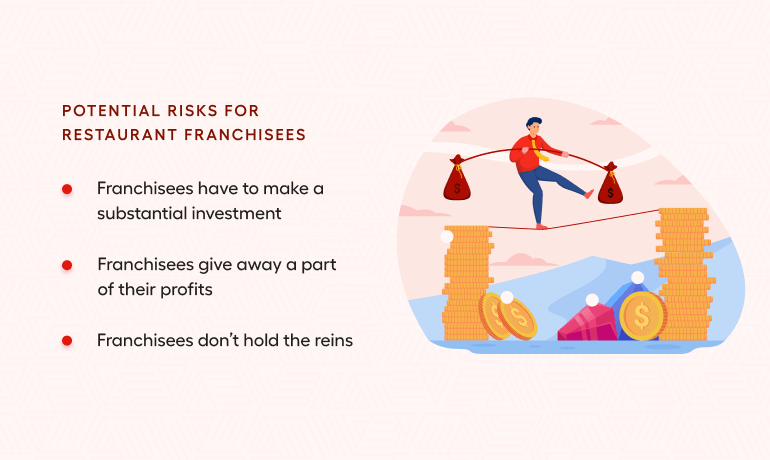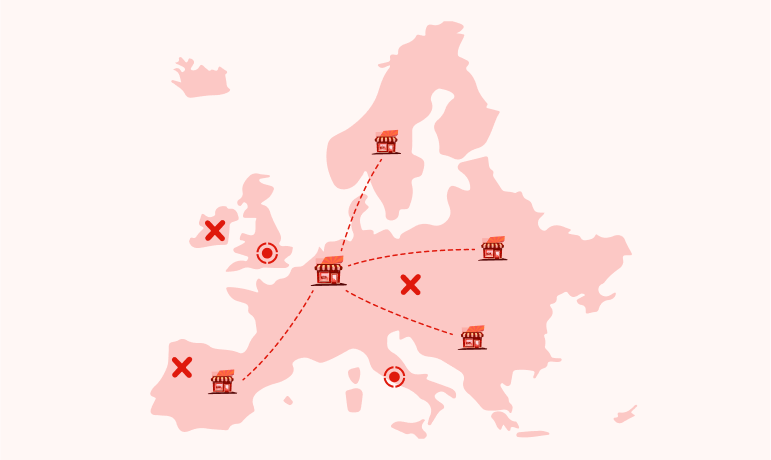Franchising is a time-tested business model that allows restaurant owners to scale their business fast and efficiently.
However, like every business model, it has a few drawbacks you should consider.
In this post, we are NOT exploring the benefits of a restaurant franchise. Instead, we embrace the dark side and look at the pain points and pitfalls.
Rest assured, we also explain how to avoid those treacherous potholes. Every pitfall mentioned in this article includes a solution (which reminds me, you should also look into best practices for F&B franchising).
As a franchisor, you will partner with independent investors. These partnerships are built on solid relationships, so it helps to understand the challenges your franchisees are facing. We’ve included those at the bottom of the page to give you a complete picture of the risks of franchising your foodservice brand.
Brace yourself. Here we go.
First question: does your restaurant concept qualify at all for franchising?
4 Signs You Are Not Ready To Franchise
While it can be an opportunity for many restaurant businesses, expansion through franchising isn’t necessarily a great move for you.
So before we move on to the pitfalls of restaurant franchises, we’ll share a few key questions to ask yourself.
Think of them as a reality check.
Before you take the plunge, you’d better make sure your F&B concept is a good candidate for franchising. If it is not, you can tinker with it until it is. That is much more difficult once you have investors on board. Then it is like trying to repair a plane in full flight: not advisable.

How To Franchise A Restaurant?
Develop your franchise using a proven roadmap for franchisors.
✅ Free download
Ask yourself these questions.👇
1. Does my business have a well-defined concept?
Start by assessing your salability: do you have a credible and unique concept attractive to budding restaurant owners?
Try to find indicators that your franchise is in demand. For example, have you received requests, questions, or unsolicited applications from investors looking to open a franchise?
Verify that both customers and employees understand your brand concept.
A strong concept is the cornerstone of a franchise business. People should be able to describe your brand and what it stands for quickly and define its value. Surveying their answers will tell you whether you run a restaurant concept that is well-defined and appealing (and therefore salable).
2. Can my concept be replicated easily?
Ask yourself next whether you can easily clone your restaurant.
Consistency is vital in any restaurant, but it’s even more critical for franchises. Guests expect your food to taste the same, no matter which location they visit or order from. They also expect a consistent menu, interior design, and ambience across restaurants.
Each restaurant within your franchise will have to replicate your dishes and dining experience using the resources and expertise you provide. That’s where an extensive operations manual comes in, including your processes, recipes, portion sizes, suppliers, safety and hygiene guidelines, equipment, pricing, appropriate furnishings, etc.
On top of the manual, you’ll also need to dedicate time to training new franchisees for at least several weeks.
3. Do I have a strong track record of profitability?
Starting a franchise typically makes sense only if your company-owned restaurant outlets are profitable. Investors want to see that your business has been making a profit for at least a few years.
Therefore, financial transparency is key. You should be able to give potential franchisees a complete overview of their estimated expenditure, from the initial start-up investment to infrastructure, licenses, and royalty fees.
Most importantly, you need to make sure both you and your franchisee will get a good return on investment (ROI) from your restaurant – even after a deduction of recurring monthly royalty fees.
Besides cost estimations, you should share financial statements and projections. Audited financial statements can reassure potential business owners and investors.
You will also need to estimate the expected growth rate for at least the first year of the franchise business, calculate the restaurant cash flow, and determine the payback period (the time it will take to cover the capital expenditure). We suggest focusing on your earnings before interest and taxes (EBIT) to estimate cash flow.
Generally, an EBIT margin of around 15% is considered good. A payback period of two to three years is a reasonable target.
4. Have I demonstrated success in multiple locations?
While it is not a hard rule, having at least two thriving locations is recommended before launching a franchise.
Having more than one profitable restaurant is proof that your strategy and concept are working and can be replicated successfully regardless of geographical and demographic factors. It shows that your business can succeed in different markets.
However, a more important benefit of running your own units is it forces you to perfect the business and operational side of things, allowing you to make your concept as plug-and-play as possible.
Keep in mind that running an F&B business is never a true plug-and-play venture. But you can get pretty close to that elusive ideal if you put in the work.
So take the time to optimise your workflows, implement solid protocols and map out your food and beverage tech strategy before you start to look for investors.
3 Disadvantages Of Franchising Your Restaurant You Should Know

If you answered the reality check questions above, you’re sure your foodservice concept could potentially shake things up in the franchise world.
Manage group-wide menus from a centralised platform with performance dashboards.
We warned you that you should be aware of a couple of pitfalls.
#1 You’ll have to share control
Your concession owners are not your employees. They are your business partners.
That means you will have to share the control over your restaurant business with them.
While you still have the decision-making power, your franchisees are stakeholders with their own opinions and ways of running their restaurant. Some of it might rub you the wrong way. On the other hand, some of your franchise partners, and hopefully most, may bring years of industry experience to the table. It would be foolish not to be open to their ideas.
Therefore, this restaurant expansion strategy may not suit you if you are not ready to let go of parts of your business or listen to franchisees’ feedback.
The solution
While you can’t avoid sharing ownership and responsibility with franchisees, there are ways to ensure you get things right.
- First, make it easy for business owners to represent your brand passionately by providing a proven operating prototype and a well-defined branded concept.
- Secondly, spell out your entire restaurant franchising strategy in a detailed business plan.
- Finally, make sure that franchisees have a clear understanding of what they’ll be getting into. Screening potential investors and developing a preferred profile will make it easier for you, as a franchisor, to build a relationship based on shared ambitions and trust in each other’s capabilities right from the start.
#2 You’ll risk brand dilution.
When you share control with franchisees, you’re no longer in charge of every restaurant within your network. And with shared governance comes risk. For restaurants and virtual brands, those relate primarily to brand consistency.
Creating a successful restaurant franchise hinges on your ability to deliver a consistent, high-quality experience for diners across your locations, both on and off-premise.
[Streamer] Can you ensure a consistent, high-quality experience for diners across all locations, both on and off-premise?
If one of your franchise locations or host kitchens isn’t serving food that is up to standard or isn’t creating the experience your brand is known for, you risk losing clientele and destroying your reputation.
The solution
Don’t create an elaborate menu to prepare. Recipes should be simple to execute and dishes easy to assemble using your operations manual and training courses. Entry-level kitchen staff should be able to deliver consistent results.
Many multi-location foodservice operations and restaurant franchises opt for a central kitchen run by the franchisor or an independent food production company. The tricky part is the logistics behind such a venture, but that obstacle is easily overcome with tech for internal ordering.
You shouldn’t just focus on the food. The overall guest experience is equally important. You want your guests to remember the excellent service, the general ambience, the fun decor, and maybe even that catchy playlist they listened to during dinner.
So again, ensuring that you have a strong brand identity and replicable concept is essential to avoid brand dilution.
#3 You are (partially) responsible for your franchisees’ success.
Finally, your franchisees’ success significantly depends on the support they get from you.
While new restaurant owners will be in charge of their location, they rely on the franchisor’s added tools and resources. Therefore, your ability to support, guide and train them is strongly related to their (and hence your) success.
The solution
Invest in comprehensive training materials to help franchisees successfully replicate the concept and represent your brand.
You’ll want to have both initial and ongoing training programs to ensure franchisees have everything they need to succeed at all times.
We recommend hiring a skilled training team to assess training needs, set organisational objectives, and establish and implement training activities.
You should also build a good support network to enable franchisees to share knowledge and communicate with each other.
Also, invest in your restaurant tech ecosystem.
Rest assured, none of the big-name restaurant franchises in the QSR, fast-casual or virtual space have grown to their current size by allowing franchisees to spreadsheet their way through operations and finances.
They have restaurant technology that helps their partners make more money while providing insights into sales and F&B workflows. It allows them to spot discrepancies sooner. Data sharing via API ensures that all tech within the restaurant ecosystem is using the same numbers for sales, labour and inventory.
3 Risks Franchisees Face When Buying Your Restaurant Concept

To improve your odds of building a winning franchise empire, you need to understand (and eliminate) the possible disadvantages for entrepreneurs investing in your brand.
#1 Franchisees have to make a substantial investment.
Potential business owners purchase the license to use your brand, trademark, and concept. That’s just the start of their financial commitment. They also invest in their restaurant’s decor, kitchen, dining area, equipment, and other elements.
Potential franchisees have to be able and prepared to make a significant upfront start-up investment. The actual costs of opening a franchise restaurant sit anywhere between 100K and well over a million.
Typically, franchisees also need to prove that they have a minimum net worth and working capital to cover unexpected costs or expenses.
That’s a lot of money. Franchisees will expect proof your concept is solid. Who can blame them?
The solution
Investors expect full financial transparency before committing.
You can prepare answers to all their questions by focusing on your EBIT, providing financial statements and cost estimations, approximating cash flow, and showing them a strong track record of profitability across locations.
Doing so will help you make a compelling case for investing, but it will also make it easier for investors to secure a loan.
#2 Franchisees give away a part of their profits.
To keep using your licenses and resources, franchisees pay ongoing royalties for the entire duration of the agreement. Royalty fees are usually collected monthly and range from 4% to 10% of monthly revenue.
The solution
Franchisee profitability should be as important a goal as your profit growth as a franchisor.
Don’t make the mistake of looking at your profit and loss statement to estimate the return on your franchise. Instead, determine if franchisees can make a reasonable return by factoring in between 4% and 10% for royalties and other unexpected costs. Your profit picture may look completely different.
Also, monitor not-so-obvious KPIs such as food cost variance, inventory turnover and food waste. Together with revenue and sales, they paint a complete picture of the situation at franchised locations. Additionally, these restaurant metrics provide benchmarks that will help you assess the health of your restaurant franchise network.
#3 Franchisees don’t hold the reins.
While the menu can have minor regional differences, all your outlets should serve the same food, use the same branding, and follow general operating procedures.
They typically won’t get a say in operating hours, advertising, menus, or staff structure. In addition, franchisees are always held accountable to you.
They have to abide by the standards designed by HQ and respect the franchise agreement at all times. If they don’t, you can decide to terminate the agreement or not renew their contract, causing the franchisee to lose their investment.
This agreement may discourage franchise owners who feel they lack freedom or independence.
The solution
Investing in the relationship with your franchisees is essential to reach your goals and sustainably scale your operation.
It is vital to set expectations before signing the franchise agreement. We suggest you encourage potential business owners to talk with existing franchisees to see what a partnership looks like in practice.
When franchisees come on board, be open to their feedback and acknowledge their hard work. Treat them like business partners and always ask for their input before making big decisions that could impact them and their team. Don’t forget to explain the rationale for said decisions.
Additionally, provide franchisees with all the resources and information to thrive. By helping them to run their business as efficiently as possible, you give them back time that they can use to reflect on their restaurant. Their innovative ideas might give your business the competitive edge you need to maintain healthy growth.
Leverage Technology To Overcome Operational Pitfalls

Being aware of the common pitfalls of restaurant franchises and knowing how to avoid them will help you survive and thrive. But there’s something else you can do to improve your chances of success: invest in restaurant management technology.
Selecting the right tech will enable smooth day-to-day operations in each of your restaurants. In addition, it will ensure BOH and FOH efficiency (and consistency) for years to come.
As a result, you can scale your business faster and more efficiently, ultimately generating more revenue.
Research what features the ideal tech solution needs to become your franchise’s backbone.
We suggest looking into software that helps you:
- create a scalable recipe database you can roll out to all locations;
- keep track of inventory at each location to keep stock accurate down to the raw ingredients;
- set up fully calculated production plans for all your outlets;
- monitor food safety procedures centrally;
- eliminate costly purchasing mistakes in each of your locations.
The right technology will allow you to manage all your online orders across delivery platforms and locations from a single device and then analyse your top-selling dishes and restaurants.

How Tech Improves Consistency
Apicbase is the F&B backbone of thousands of restaurant outlets in Europe, the UK and the Nordic countries.
We’d love to show you why popular brands such as Oli Oli, Not So Dark, citizenM, and The Avocado Show have automated menu management, procurement and inventory management using our F&B management platform.
Let us help you crush your goals.



